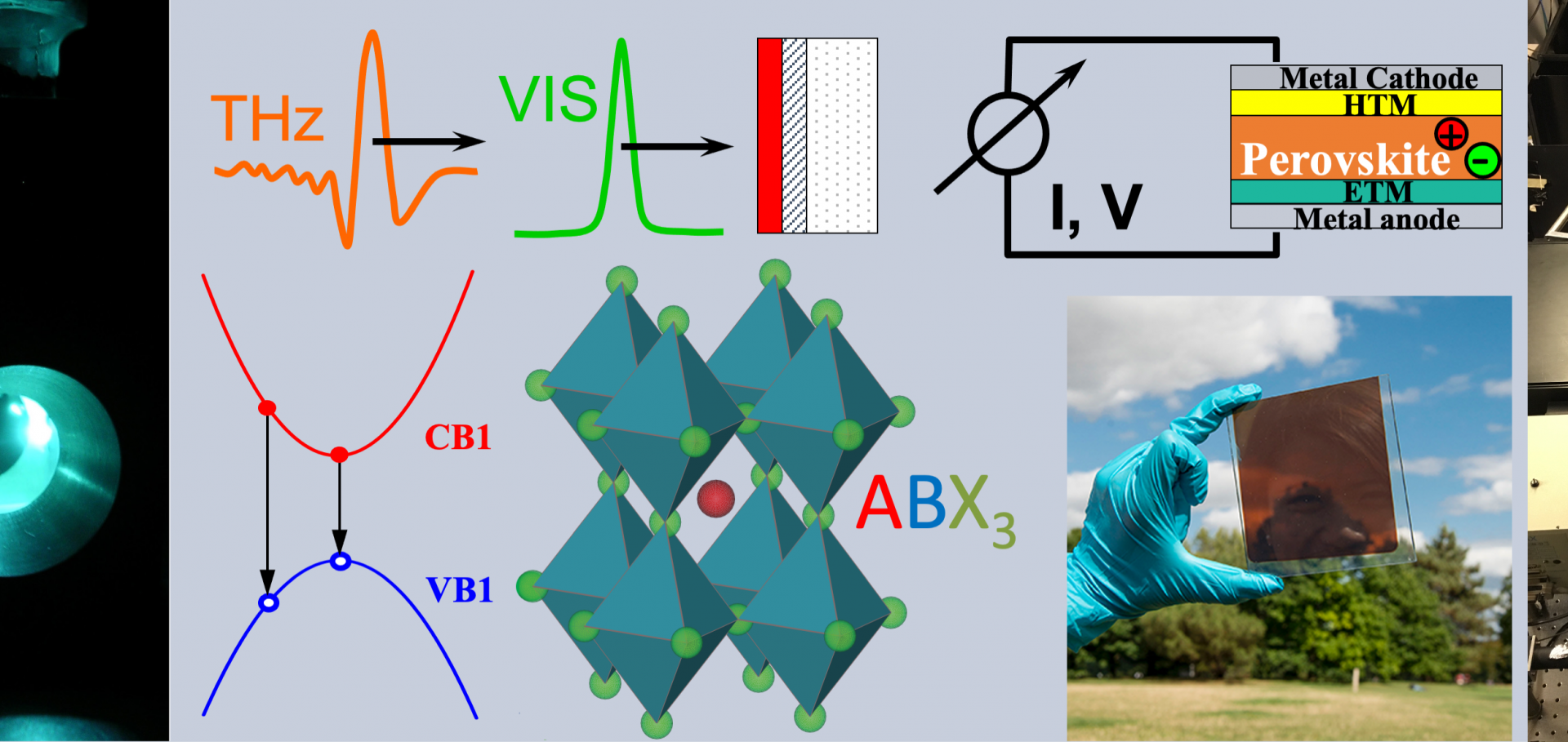Charge-Carrier Trapping Dynamics in Bismuth-Doped Thin Films of MAPbBr3 Perovskite.
The journal of physical chemistry letters American Chemical Society (ACS) 11:9 (2020) 3681-3688
Abstract:
Successful chemical doping of metal halide perovskites with small amounts of heterovalent metals has attracted recent research attention because of its potential to improve long-term material stability and tune absorption spectra. However, some additives have been observed to impact negatively on optoelectronic properties, highlighting the importance of understanding charge-carrier behavior in doped metal halide perovskites. Here, we present an investigation of charge-carrier trapping and conduction in films of MAPbBr3 perovskite chemically doped with bismuth. We find that the addition of bismuth has no effect on either the band gap or exciton binding energy of the MAPbBr3 host. However, we observe a substantial enhancement of electron-trapping defects upon bismuth doping, which results in an ultrafast charge-carrier decay component, enhanced infrared emission, and a notable decrease of charge-carrier mobility. We propose that such defects arise from the current approach to Bi-doping through addition of BiBr3, which may enhance the presence of bromide interstitials.CsPbBr3 nanocrystal films: Deviations from bulk vibrational and optoelectronic properties
Advanced Functional Materials Wiley 30:19 (2020) 1909904
Abstract:
Metal‐halide perovskites (MHP) are highly promising semiconductors for light‐emitting and photovoltaic applications. The colloidal synthesis of nanocrystals (NCs) is an effective approach for obtaining nearly defect‐free MHP that can be processed into inks for low‐cost, high‐performance device fabrication. However, disentangling the effects of surface ligands, morphology, and boundaries on charge‐carrier transport in thin films fabricated with these high‐quality NCs is inherently difficult. To overcome this fundamental challenge, terahertz (THz) spectroscopy is employed to optically probe the photoconductivity of CsPbBr3 NC films. The vibrational and optoelectronic properties of the NCs are compared with those of the corresponding bulk polycrystalline perovskite and significant deviations are found. Charge‐carrier mobilities and recombination rates are demonstrated to vary significantly with the NC size. Such dependences derive from the localized nature of charge carriers within NCs, with local mobilities dominating over interparticle transport. It is further shown that the colloidally synthesized NCs have distinct vibrational properties with respect to the bulk perovskite, exhibiting blue‐shifted optical phonon modes with enhanced THz absorption strength that also manifest as strong modulations in the THz photoconductivity spectra. Such fundamental insights into NC versus bulk properties will guide the optimization of nanocrystalline perovskite thin films for optoelectronic applications.Control over crystal size in vapor deposited metal-halide perovskite films
ACS Energy Letters American Chemical Society (ACS) 5 (2020) 0c00183
Abstract:
Understanding and controlling grain growth in metal halide perovskite polycrystalline thin films is an important step in improving the performance of perovskite solar cells. We demonstrate accurate control of crystallite size in CH3NH3PbI3 thin films by regulating substrate temperature during vacuum co-deposition of inorganic (PbI2) and organic (CH3NH3I) precursors. Films co-deposited onto a cold (−2 °C) substrate exhibited large, micrometer-sized crystal grains, while films that formed at room temperature (23 °C) only produced grains of 100 nm extent. We isolated the effects of substrate temperature on crystal growth by developing a new method to control sublimation of the organic precursor, and CH3NH3PbI3 solar cells deposited in this way yielded a power conversion efficiency of up to 18.2%. Furthermore, we found substrate temperature directly affects the adsorption rate of CH3NH3I, thus impacting crystal formation and hence solar cell device performance via changes to the conversion rate of PbI2 to CH3NH3PbI3 and stoichiometry. These findings offer new routes to developing efficient solar cells through reproducible control of crystal morphology and composition.Light absorption and recycling in hybrid metal halide perovskites photovoltaic devices
Advanced Energy Materials Wiley 10:10 (2020) 1903653
Abstract:
The production of highly efficient single‐ and multijunction metal halide perovskite (MHP) solar cells requires careful optimization of the optical and electrical properties of these devices. Here, precise control of CH3NH3PbI3 perovskite layers is demonstrated in solar cell devices through the use of dual source coevaporation. Light absorption and device performance are tracked for incorporated MHP films ranging from ≈67 nm to ≈1.4 µm thickness and transfer‐matrix optical modeling is utilized to quantify optical losses that arise from interference effects. Based on these results, a device with 19.2% steady‐state power conversion efficiency is achieved through incorporation of a perovskite film with near‐optimum predicted thickness (≈709 nm). Significantly, a clear signature of photon reabsorption is observed in perovskite films that have the same thickness (≈709 nm) as in the optimized device. Despite the positive effect of photon recycling associated with photon reabsorption, devices with thicker (>750 nm) MHP layers exhibit poor performance owing to competing nonradiative charge recombination in a “dead‐volume” of MHP. Overall, these findings demonstrate the need for fine control over MHP thickness to achieve the highest efficiency cells, and accurate consideration of photon reabsorption, optical interference, and charge transport properties.Trap states, electric fields, and phase segregation in mixed-halide perovskite photovoltaic devices
Advanced Energy Materials Wiley 10:9 (2020) 1903488


